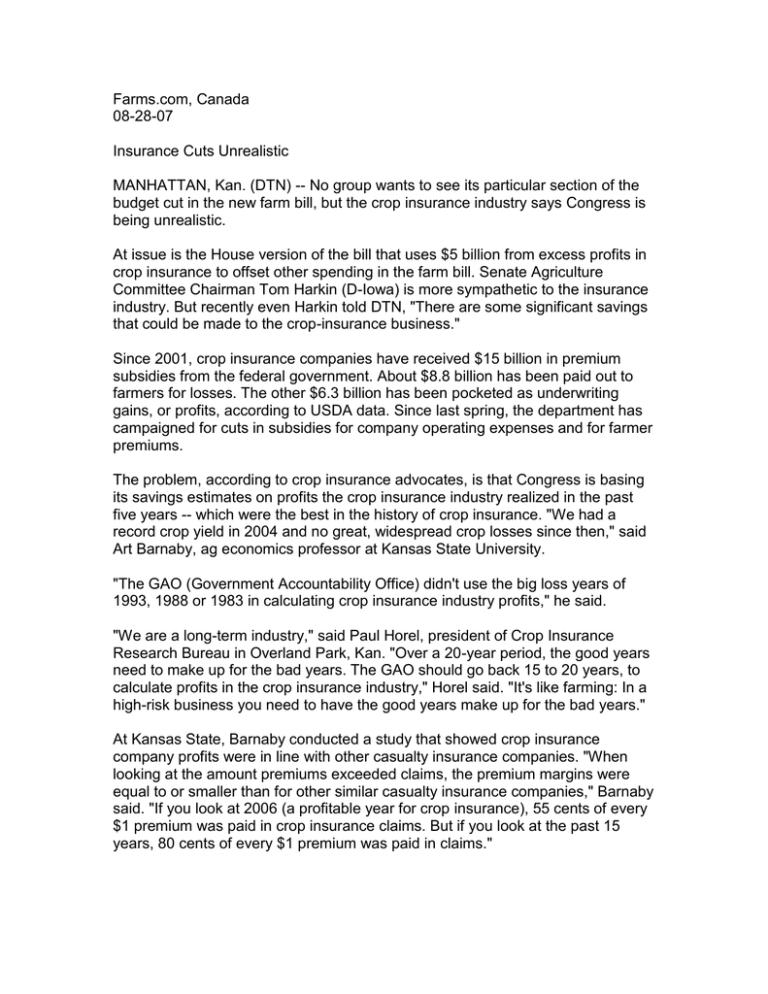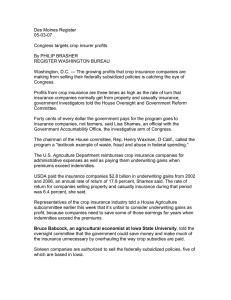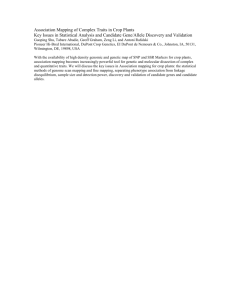
Farms.com, Canada
08-28-07
Insurance Cuts Unrealistic
MANHATTAN, Kan. (DTN) -- No group wants to see its particular section of the
budget cut in the new farm bill, but the crop insurance industry says Congress is
being unrealistic.
At issue is the House version of the bill that uses $5 billion from excess profits in
crop insurance to offset other spending in the farm bill. Senate Agriculture
Committee Chairman Tom Harkin (D-Iowa) is more sympathetic to the insurance
industry. But recently even Harkin told DTN, "There are some significant savings
that could be made to the crop-insurance business."
Since 2001, crop insurance companies have received $15 billion in premium
subsidies from the federal government. About $8.8 billion has been paid out to
farmers for losses. The other $6.3 billion has been pocketed as underwriting
gains, or profits, according to USDA data. Since last spring, the department has
campaigned for cuts in subsidies for company operating expenses and for farmer
premiums.
The problem, according to crop insurance advocates, is that Congress is basing
its savings estimates on profits the crop insurance industry realized in the past
five years -- which were the best in the history of crop insurance. "We had a
record crop yield in 2004 and no great, widespread crop losses since then," said
Art Barnaby, ag economics professor at Kansas State University.
"The GAO (Government Accountability Office) didn't use the big loss years of
1993, 1988 or 1983 in calculating crop insurance industry profits," he said.
"We are a long-term industry," said Paul Horel, president of Crop Insurance
Research Bureau in Overland Park, Kan. "Over a 20-year period, the good years
need to make up for the bad years. The GAO should go back 15 to 20 years, to
calculate profits in the crop insurance industry," Horel said. "It's like farming: In a
high-risk business you need to have the good years make up for the bad years."
At Kansas State, Barnaby conducted a study that showed crop insurance
company profits were in line with other casualty insurance companies. "When
looking at the amount premiums exceeded claims, the premium margins were
equal to or smaller than for other similar casualty insurance companies," Barnaby
said. "If you look at 2006 (a profitable year for crop insurance), 55 cents of every
$1 premium was paid in crop insurance claims. But if you look at the past 15
years, 80 cents of every $1 premium was paid in claims."
If the companies that administer crop insurance have their level of compensation
reduced, it could ultimately affect farmers in a big way. "If we were always going
to have profits, it would be okay to reduce the level of compensation we get from
the government," Horel said. "But that's not the case. If a widespread crop
disaster occurs, we could see some serious fallout in the crop insurance industry.
And that would affect producers: Insurance companies would have to cut back on
expenses by having fewer adjusters and fewer field representatives to help
agents. Serious losses would result in companies selling out, merging or filing
bankruptcy. Marginal, high-risk areas would be dropped from coverage. We've
already had crop insurance providers pull out of North Dakota, the southeast
U.S. and Texas," he said.
"No one knows when the next bad year will come," Barnaby said. "But Iowa
State University climatology professor Elwyn Taylor said if we don't have a
widespread U.S. drought by 2011, that would be the first time in 800 years we
haven't followed that weather cycle."
"It's a delicate balance to keep the private crop insurance and re-insurance
industry viable. But it's necessary. You don't want the government providing crop
insurance. We've tried that before and it was not successful," Horel said.
Crop insurance lobbyists have said $1 billion, not the House bill's $5 billion, could
be cut from the crop insurance program before service to producers would be
sacrificed.
The main industry objection of the House bill is that it increases the "quota share"
or how much the federal government receives from crop insurance underwriting
gains. The quota share jumps from a current 5 percent to a minimum of 12.5
percent. The Bush administration went as far as to propose taking 22 percent of
underwriting gains, Barnaby said.
Other large savings would come from a 2.9 percent cut in the reimbursement
rates to crop insurance providers for "administrative and operating" costs.
"Our system isn't perfect," said Horel, whose organization conducts education
and training programs for crop insurance providers. "But it is looked upon as a
model for other countries. We've had representatives from Israel, South Africa,
South Korea, Australia and Canada studying our crop insurance program to see
how they could duplicate it in their countries. It's important to keep our program
viable."
(SS/SK)
Copyright 2007 DTN. All rights reserved.
Powered By DTN




